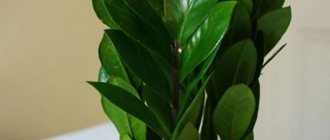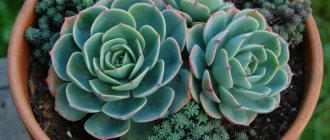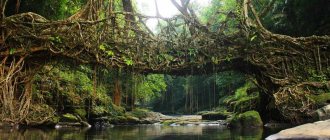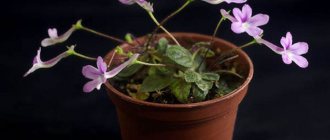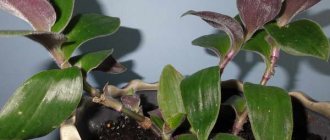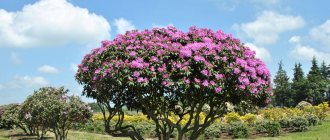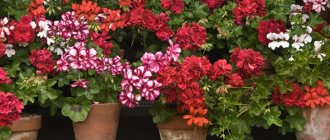Epistation: botanical description
Species of the genus Episcia are perennial herbaceous plants. The root system of plants is fibrous.
Species of the genus Episcia have two types of shoots: shortened with close opposite leaves or thin and long stolons bearing daughter rosettes. The shoots of the plants are creeping.
The leaves of the plants are elliptical, sometimes ovate. The leaves are large, wrinkled, velvety-pubescent or shiny, olive green, copper brown, silver with veins of a different color, or green with a copper or silver pattern.
There are many hybrid forms of plants with unusual leaf colors: chocolate brown, raspberry-pink with a silver midrib, light green combined with white and coral, brown with streaks of pink-pearl color.
The flowers of species of the genus Episcia are axillary, often solitary, small in size, but very beautiful. The color of the corolla can be white, red, yellow, golden yellow and mauve. Hybrids also have flowers in bright orange, lavender blue and light cream. There are 4 stamens in a flower.
Characteristics of episcia types
Root system: fibrous, medium developed.
Stem: soft, thin, long or short with densely spaced leaves, creeping.
Important: Episcias are cultivated as hanging flowers, suitable for life in hanging pots, precisely due to the formation of long shoots after the stem has drooped, hanging over the edge of the pot.
Leaf blades: finely crenate along the rim, oppositely located, rather large, densely pubescent, with a shiny/matte/smooth surface; the color palette is very diverse, and rarely green.
Leaf Shape:
- Elliptical
- Broadleaf
- Broad-ovate
Important: a distinctive feature of episcias is the crazy variety in leaf colors. The emphasis is rarely placed on the green color of the leaves, although its unique speckled patterns in shades of marsh and light green look no less magical than golden tiger with brown, or dusty pink with thick scarlet pubescence.
Flowers: axillary “gramophone” 3 x 2 cm; in shades of scarlet, orange, lavender, blue, cream, yellow and pink (for example, episcia copper); rarely – speckled; each flower has 4 stamens; single; tubular.
Episcia: varieties, names, types
All types of Episcia are distinguished by their particularly decorative foliage, which in each species has a variety of fabulous colors - red, copper, purple, brownish-green and even blue. The carved shape of the foliage enhances the effect of the bright colors, and during flowering the plant is covered with many bright, expressive flowers.
Episcia will fit perfectly into the interior of your home, both as a potted plant and as an hanging plant, and can decorate your balconies and terraces. We will introduce you to the most popular species and varieties of Episcia in indoor floriculture, which were bred in huge numbers by enthusiastic breeders.
Episcia cupreata
Episcia Copper
This is the most popular type of plant among gardeners. Valued for its large velvety leaves with a fine mesh of silver veins, making the dissected pattern three-dimensional. The olive green leaves have a copper tint, fine teeth and a mottled maroon edge.
However, in this Episcia there are also other various combinations of shades in the coloring of the leaves.
The leaf length is from 7 to 12 cm, it is oval or heart-shaped. The flowers are bright red with wide petals. They most often have yellow tubes and orange lips. The flower size is small, only 2 cm in length, but there are so many of them that the bush looks very attractive. Flowering occurs from July to September.
Episcia Silver
It is worth highlighting among the types of silver epicia – Silver Sheen and Silver Skies.
- Silver Sheen (Silver Shine) - this species was bred on the basis of the Copper Episcia. It is characterized by large, bright, pubescent leaves with light green veins and a copper-olive edging. Most of the leaf surface, especially in the center, is silver in color. Brownish-purple square-shaped inclusions appear closer to the edges. The flowers are orange-red.
Episcia Silver Sheen
- Silver Skies is a fast-growing, small-leaved hybrid variety with all-silver foliage set against bright orange-red flowers.
Episcia Silver Skies
Episcia Violet
Episcia Violet
This species has much in common with Episcia Copper, but it has much fewer varietal forms. It has jagged, reddish-purple foliage that is red at the bottom. The veins are painted in different colors. The flowers are larger than those of Episcia Copper, and they are painted in pale lilac or blue tones. Their edges are serrated.
Blue Nile
Episcia Blue Nile
This is a varietal form of Episcia Lilac. It differs from it in its large blue flowers with a lavender tint. (Note that Episcia with blue or dark blue flowers is extremely rare among varieties). The center of the flower is yellow. The leaves are brownish-green, heavily hairy, and have broad olive-green herringbone stripes along the midribs.
Episcia Dianthiflora
Episcia Dianthus
This ampelous type of Episcia with dense foliage of bluish-green color looks like an amazing exotic. It has two types of shoots - long, mustache-like shoots bearing daughter rosettes, and short leafy shoots that form bushes.
Ellipsoidal velvety small leaves, no more than 3 cm long and about 1 cm wide, cover stemless rosettes and oblong shoots rooted at the nodes. The edges of the leaflets are crenate, the color is dark green, with a purple line in the center of the leaf.
The large white flowers of this Episcia with a fringed-carved limb and beautiful purple speckles along the throat are tube-shaped, which creates a resemblance to carnation flowers. Blooms from June to September.
Creeping (Episcia reptans)
Episcia Reptans
This plant is grown only as a hanging plant. It has long flexible stems. Rarely found on sale. The leaves are long, up to 10 cm, oval, colored differently depending on the conditions of detention. Thus, in shaded conditions the foliage becomes silvery-green, and in strong light, on the contrary, it becomes brown.
In addition, the surface is decorated with all kinds of spots and stripes. All its hybrids are endowed with this effect.
Scarlet flowers have fringed edges. They appear from July to September.
Episcia Watercolor
Most varieties of Episcia do not require additional conditions, such as high humidity, but there are a number of varieties with variegated leaves that require a special approach. They are called "watercolor" because of the unusual coloring of the leaves.
The leaves of watercolor episcias are incredibly beautiful, with a predominance of blurred soft pink, coral, cream and soft green tones, and the design on them resembles the artist’s imagination. But they require high humidity to grow: they grow more slowly and are more difficult to reproduce due to the large number of chlorophyll-free areas.
In Russia, such varieties as 'Cleopatra', 'Moonlit Valley', 'Peppermint Brocade', 'Pink Brocade', 'Pink Dreams', 'Unpredictable Helen' and others are known. There is a variety that can grow outdoors - this is 'Unpredictable Valley', the most unpretentious of all.
Episcia watercolor
Any glass containers are suitable for containing watercolor paintings: balls, cubes and even glasses (the top of the container must be covered with film or a lid with several holes for ventilation). Air humidity must be at least 80%, otherwise the plants will lose turgor. These are real sissies!
The soil for them is high-moor peat with the addition of perlite without weighting ingredients such as sand or expanded clay.
Light, air and humidity are what you need to grow watercolor episcia. But avoid direct sunlight, otherwise there is a risk of “cooking” the plant.
Episcia Pink
Let's look at 3 varieties of pink epicion - Pink Brocade, Pink Panther, Pink Smoke.
- Pink Brocade - this variety is unique in that in some places the leaves, devoid of chlorophyll, have a wide border of white and pink with bright pink dots. The middle of the leaf is painted in silver and light green colors.
Episcia Pink Brocade
- Pink panther is a varietal species of Episcia. It is distinguished by its large size and ease of care. Its leaves have a lime-green color, sometimes with a bronze tint. Their length is up to 15 cm. The flowers are large, bright light pink with a corrugated edge.
Episcia Pink Panther
- Pink Smoke - bushes of this variety are decorated with pink spots along the edges of the leaves and rich pink flowers.
Episcia Pink Smoke
Episcia Emerald Velvet
Episcia Emerald Velvet
Beautiful herbaceous plants that can be safely classified as both decorative deciduous and flowering. The bushes have compact sizes and oval or heart-shaped, velvety pubescent leaves.
The main shade of the leaf blades is dark green, but the veins are often highlighted in a lighter color.
During the flowering period, the plant produces delicate lilac or bluish flowers with five rounded petals and a long flower tube.
Episcia Chocolate
Here we can distinguish 3 popular types - Chocolate velor, Chocolate soldier, Chocolate cream.
- Chocolate Velor has a special charm. Its densely pubescent, dense leaves of a brownish-violet color have a pink mother-of-pearl shimmer, and lilac-blue flowers make you want to stroke the plant. A very popular variety, resistant to environmental factors and easy to care for.
Episcia Chocolate velor
- Chocolate Soldier - almost the entire surface of the brownish-green leaf is covered with silver-blue spots. Blooms with dark burgundy flowers.
Episcia chocolate Soldier
- Chocolate Cream is decorated with white or red flowers with fringed edges and white-silver or pink marbled veins on chocolate brown leaves.
Episcia Chocolate Cream
Episcia My Precious
Episcia My Precious
This variety has large, glossy, lumpy leaves of a light green color and pearlescent veins. The flowers are yellow, the edges of the petals are lighter.
Other hybrid varieties
- Episcia Pink Acajou has silvery-green foliage interspersed with whitish-green stitches and pink splashes. The orange-red flowers have a yellow throat.
Episcia Pink Acajou
- Episcia Gray lady has leaves of medium size, pubescent, serrated, olive in color. The flowers are usually red or orange with yellow polka dots.
Episcia Gray Lady
- Episcia Cleopatra is a spotted variety with dark green leaves with light pink spots that often cover most of the leaf blades.
Episius Cleopatra
- Episcia Tiger stripe has swamp-colored foliage with silver veining, similar to patterns on tiger skin, and scarlet-colored flowers.
Episcia Tiger Stripe
- Episcia Strawberry patch. The leaves of this variety are small, sharp, and bright pinkish-red in color. The flowers are scarlet with a yellow throat.
Episcia Strawberry patch
- Episcia Ronnie is a particularly beautiful variety. Its foliage is chocolate brown with silver-green veins. The coral-red hue of the flowers effectively complements this picture.
Episcia Ronnie
- Episcia Degas is a large plant with red flowers and brown-green leaves with deep greenish veins.
Episcia Degas
Description
Episcia is valued for its foliage. It comes in a variety of colors: emerald, jade, bronze, copper, silver. The greenery shimmers with mother-of-pearl. In many species, a pattern is observed along the central region of the leaf.
Leaf plates have different shapes: round, oval, elliptical. Their surface can be smooth with shine or pubescent, similar to velvet. The edges are smooth and jagged.
A bell-shaped inflorescence on a short stalk with 5 petals. Blooms in July-September. The formation of fiery red buds occurs in single quantities or in bouquets. It has creeping shoots and tendrils, like strawberries. Thanks to them, the plant reproduces.
Epistomy care table
Episcia at home requires certain care:
| Temperature | Throughout the year 20-25°. |
| Air humidity | High. |
| Lighting | Diffused, windows facing east or west. |
| Watering | Regular, moderate. The soil should never dry out. |
| Priming | Lightweight, breathable substrate with a slightly acidic reaction. |
| Feeding and fertilizer | In the spring-summer period 2 times a month. |
| Episcia transplantation | In spring, once every 2-3 years. |
| Reproduction | Rooting mustaches and cuttings, sowing seeds. |
| Features of cultivation | Loves ventilation, but does not tolerate drafts. |
Episcia - care and reproduction
She is quite unpretentious, but sometimes she is affected by diseases. The most common is root rot. When affected, the leaves wither and the roots become soft.
For prevention, it is necessary to constantly drain excess water to avoid the formation of stagnation. When replanting, use the drug Gliokladin if you notice signs of rot. To get rid of the disease, disinfect the pot and all tools.
How to care for episcia at home
To maintain the beautiful color of any variety of episcia, it is necessary to create suitable conditions for the bush. This is not so difficult, especially if you immediately choose the right place for the flower.
Lighting and temperature
If the plant does not have enough light, it will not bloom profusely and maintain the variegation of its leaves. This does not mean that the pot should be placed in the sun, but daylight hours should not be shorter than 12 hours.
Important! Delicate pubescent foliage will become covered with brown burns from direct sunlight. Therefore, the plant should not be subjected to such stress, especially when it is standing on a southern windowsill.
The plant feels best on eastern and western windows with additional lighting in winter. Otherwise, for example, the Malay ebony variety will lose its red veins without additional lighting.
Comfortable air temperatures for episition are in a small range from 20 to 25 °C throughout the year. In winter, it is important to take into account the decrease in thermometer readings near the window and the possibility of cold drafts, which has a detrimental effect on the flower.
Watering
Caring for a flower at home does not require much effort. It should be watered only when the soil dries out a little, but there is no need to let it dry completely. To avoid diseases characteristic of this flower, you must avoid the accumulation of water at the bottom.
In addition, you should not splash the casting, but just wet the soil exclusively. It is better to water with soft water that has already settled. In winter you can do this less, because in cold weather the plant does not need moist soil.
Humidity
This flower grows and develops well in small greenhouses or terrariums, because it needs high air humidity. It is impossible to moisten the foliage with a spray bottle, since there is pubescence on its surface, and if water gets on it, this can lead to rot.
In this regard, to increase air humidity, it is recommended to pour moistened expanded clay into the pan, and then place a pot of episcia on it. At the same time, make sure that the bottom of the container does not come into contact with the liquid.
Spraying
Like most people from the tropics, it needs high air humidity. At the same time, it is extremely undesirable to spray the plant itself. Hairy leaves rot very quickly from direct contact with water. To increase the humidity level, place the pot with the plant on a tray with wet expanded clay or moss.
Top dressing
Fertilizers are applied only in the warm season, during the period of active development of the epidemic. She is fed once every 10-14 days. For this purpose, both specialized fertilizers for Gesneriaceae and complex fertilizers are used.
Please note that if complex or organic fertilizers are used, they should be diluted twice as much as indicated in the instructions for the fertilizer.
Trimming
Episcia grown indoors grows very quickly. If you want the bush to be lush and compact, then when it fades, you need to shorten it. Daughter rosettes from cut shoots are planted next to the mother bush in the same container.
Ampelous varieties are distinguished by very fast growth, they spread strongly and can take root in neighboring flower pots. In order to avoid this, the container with the flower is hung in such a way that its stems cannot reach neighboring pots.
Pot
Epission in a flowerpot
The pot for epicia must be large enough, since the plant has a voluminous root system. But the size of the pot should always correspond to the size of the flower itself, that is, you should not plant a young plant immediately in a huge pot.
It is also worth selecting pots for dwarf species of the same size, and for large-leaved and wide-spreading ones - a much larger volume. It is better to replant the bush as it grows into a larger pot, even several times a year.
Pots should be wider than deep, and always have drainage holes. Note that the episcia blooms only when it fills the entire pot with its roots.
Episcia in winter
In winter, the plant will not have enough natural light, even near southern windows. You will have to think about additional lighting for the bush. You can use fluorescent lamps, phyto lamps, or at least a floor lamp for this. Protect the flower from drafts and proximity to heating devices. In a dry room, to increase air humidity, place the pot with episcia in a tray with damp moss. Watering should be reduced to once a week. If the room is cool, then water only after inspecting the top layer of soil in the pot - it should dry out well.
Kinds
Episcia dianthiflora
A perennial plant native to Mexico, which has two types of shoots: the first are short, with closely spaced leaves; the second are thin and long, which darken over time, which take root with tendrils in the nodes and have daughter rosettes. Small small ovoid leaves: width – 2 cm, length – 3 cm. The leaves are slightly pubescent, dark, green with a scarlet midrib. The flowers are white, fringed at the edges, with purple spots in the throat.
Episcia cupreata
It grows in the tropical zone of South America at an altitude of 2 km above sea level. The size of this species significantly exceeds the size of the previous one. Creeping shoots take root in the substrate without any problems. The leaves are heavily pubescent, elliptical in shape, up to 8 cm wide and up to 30 cm long; the shade of the upper part of the leaf is from green-brown to copper with a white stripe on the middle vein, the bottom of the leaf is red with a green stripe. The flowers are solitary, red. The corolla tube is red on the outside and yellow with red spots on the inside, up to 2.5 cm long. Episcia blooms from July to September.
Episcia reptans
It grows in the same place as the previous species. An herbal plant that grows for more than one year. The leaves are much smaller - up to 8 cm long and up to five cm wide. At the base they are heart-shaped, abundantly pubescent. Red below, brown and green above (olive shade). The flowers grow in one of the leaf axils, the pedicels are red. The corolla is pink inside, red outside. Episcia blooms until September from July. Mainly grown as a hanging plant.
- Indoor trees: care, choice, features
Flowering and why episcia may not bloom
Episcia flowering
The flowering period of Episcia lasts from late spring to autumn. The flowers are tubular in shape and, depending on the species, can be red, white, lilac or yellow. With proper care it blooms very profusely. Small bell-shaped flowers almost completely cover the plant.
Why doesn't Episcia bloom? It may refuse to bloom if there is insufficient light and non-compliance with the watering regime. The pot with the plant must be moved to a brighter place, while ensuring timely watering.
When fertilized with nitrogen fertilizers, episcia grows a large number of leaves to the detriment of flowering. In this case, fertilization must be temporarily stopped.
...and diseases
Absolutely all signs of the disease are associated with improper care, namely:
- roots rot, leaf structure changes - violation of watering rules, excess light;
- episcia does not bloom - inconsistency in temperature conditions;
- brown spots appear on the leaves - the result of watering with too cold water;
- leaves turn yellow - negative effects of direct sun, excess fertilizer, low humidity;
- Powdery mildew has arisen - sharp fluctuations in temperature and humidity, lack of ventilation in the room, old, impoverished soil.
Episcia Reproduction
Plants of the genus Episcia are easily propagated by cuttings, leaves and seeds. The easiest way to propagate plants is by rooting side shoots. Propagated in spring.
The following methods of propagation of episcia are distinguished:
- Rooting of lateral rosettes on the tips of whiskers in an aquatic environment. Healthy rosettes, without being separated from the mother bush, are immersed in water to 3-4 cm to form roots.
- Rooting lateral rosettes in the soil. The shoot selected for propagation, without being separated from the mother bush, is buried in containers with moistened soil to a depth of 1-2 cm. The plant is watered with warm, settled water. The soil temperature is maintained at 18-25°C. After the rosette has rooted and active growth has begun, the tendril is cut off.
- Rooting apical cuttings. Several cuttings 10 cm long and with 2-3 nodes are cut from the mother bush. They are rooted in a container with warm water, and 1 tablet of activated carbon is added there for disinfection. Also, the cuttings can be immediately planted in a pot with a diameter of 7-9 cm and filled with light, slightly moistened soil. The cut sites are first treated with Kornevin (agents that stimulate root formation) or activated carbon. Using a jar or film, create greenhouse conditions.
- Using root shoots. Episcia has the ability to produce underground shoots, which quite often sprout in separate rosettes in the pot. They are carefully separated together with the roots and planted in separate containers.
- Reproduction by leaves. This process is quite labor-intensive and unpredictable. It is clearly noted that young plants will mature slowly and will be significantly inferior in growth to their parents. To propagate episcia, a healthy and well-developed leaf is separated from the mother bush. The wound is dried in the air and sprinkled with crushed activated carbon. Then, the plant is buried in light, slightly moist soil to a depth of 1.5-2 cm. It is necessary to control that the soil does not dry out and there is no stagnation of water. The soil temperature should be 20-25°C. To do this, create a greenhouse and ventilate it regularly.
- Seeds are the most thankless and almost impossible method of propagation for apartment conditions. Seeds are sown in containers heated from below, lightly added with water, covered with film on top, and a strict microclimate is maintained. After the seedlings grow, they are transplanted into the smallest independent pots possible.
Important: with the seed propagation method, the innovations of the variety are lost without a trace - to preserve the uniqueness, methods of cutting and leaf separation are used.
Episcia from seeds
Disinfect the soil, moisten it, sow the seeds. Without covering with soil, cover with film. The room must be ventilated daily. After 30-45 days, shoots will appear.
Propagation by leaves
Place the plucked leaves in water and wait for the roots to form (3-5 days). Plant in a pot. In a few months the first leaves will appear. The mother leaf will wither, but there is no need to tear it off, it will fall off on its own.
Planting and replanting: how to do it right
The ability of this exotic plant for rapid development and growth, as well as its tropical origin, determine a number of specific requirements for planting and transplanting episcia. In order for this beautifully flowering perennial to fully develop, feel good, bloom promptly and for a long time, the following conditions must be met in the planting procedure:
- choosing a pot of suitable volume;
- high-quality soil mixture;
- competent execution technique.
When choosing a suitable pot, it is better to give preference to not very deep, but wide containers. Considering that the roots of this plant are superficial, a moderately low and spacious pot is suitable for episcia.
Episcia pot
The optimal width of the pot is considered to be within 20 centimeters. A container of this diameter will not take up extra space on the windowsill, but will still allow the roots of the flower to fully develop. It is important to ensure that there are holes at the bottom of the pot to drain excess water.
If the episcia requires a container with a much larger diameter, it makes sense to think about dividing its bush. This procedure will rejuvenate the plant and at the same time replenish the green collection with new specimens.
When planting or replanting episcia, attention should be paid to the quality and properties of the soil mixture. This exotic prefers light, moisture- and breathable mixtures with an acidity of 5.5 pH. The plant will feel quite comfortable in a soil mixture consisting of the following components:
- leaf soil - 2-4 parts;
- peat – 1 part;
- sand - 1 part.
In the absence of leaf soil, this component can be replaced with a mixture for Uzambara violets. To improve the drainage of the soil mixture, it is allowed to add a small amount of charcoal and sphagnum moss. Before filling the pot, all ingredients of the soil mixture should be thoroughly mixed.
Before planting the plant, place a layer of drainage on the bottom of the new pot. It is recommended to use crushed expanded clay, clean pebbles or gravel as drainage. The soil mixture is poured over the drainage layer, after which the flower is carefully placed in the pot along with a lump of earth on the roots.
Drainage in a flower pot
Having placed the plant in a pot, add soil from the sides and compact it a little. The root collar is not deepened when planting. After the procedure, the plant needs to be provided with gentle conditions that will speed up its recovery process.
Briefly about cultivation
- Flowering: usually from June to September.
- Lighting: bright diffused light.
- Temperature: optimal – 20-24 ºC, but not lower than 18 ºC.
- Watering: during the growing season - abundant, using bottom watering. In winter, you can allow the substrate to dry out to a quarter of its depth.
- Air humidity: high, but episition cannot be sprayed. Place the flower on a tray with moistened expanded clay. You can grow Episcia in a terrarium next to other plants that require high air humidity.
- Feeding: during active growth - every two weeks with a solution of low concentration organic or mineral fertilizer. The dosage of fertilizer in the solution is reduced by half compared to the recommended rate.
- Rest period: not expressed. The plant feels good all year round in the same conditions.
- Pruning: after flowering is complete.
- Replanting: annually in spring.
- Substrate: slightly acidic or neutral. Composition: two parts of leaf soil and one part each of river sand and peat soil with the addition of a small amount of charcoal and sphagnum moss.
- Reproduction: by seed and cuttings.
- Pests: aphids, scale insects, whiteflies, thrips and mealybugs.
- Diseases: plant refusal to bloom, problems with leaves can occur due to violation of maintenance conditions or improper care.
Read more about growing episcia below.
Possible problems and illnesses
If the care conditions are not followed, episcia may suffer from a number of problems:
- Dry spots on leaves. Most often they are the result of cold water entering during watering. It is necessary to water along the edge of the pot with warm, pre-settled water.
- Slowly growing. The problem occurs when there is a lack of moisture. It is necessary to strictly observe the irrigation regime and not allow the soil to dry out too much.
- The stems are stretched. Shrinking of leaves and elongation of shoots is observed with a constant lack of lighting. The pot with the plant must be moved to a brighter place, shortening the elongated shoots by about a third.
- Leaves curl. This is how the plant reacts to low humidity levels. The pot with the plant must be placed on a tray with wet expanded clay, and the air around the plant must be periodically sprayed with a fine spray bottle.
- The tips of the leaves dry out. The dying of the tips of the leaf blades occurs due to too dry air. Perhaps the plant was placed next to a radiator or other heat source. The pot needs to be moved to a more suitable place.
- The leaves turn yellow and rot. Such signs indicate that the plant is flooded. It is necessary to check for drainage holes.
- Became lethargic. Most likely, the plant was kept in conditions of low temperature and high humidity. To save the episcia, it is necessary to carry out cuttings.
- Brown spots on leaves . This is how sunburn appears. The plant must be moved to a place with diffused lighting or shading must be arranged.
- Episcia leaves turn yellow . With prolonged heat and low humidity, the leaf blades begin to turn yellow. It is necessary to adjust the conditions of detention.
- A gray coating on the leaves indicates the development of a fungal disease. The plant must be treated with fungicides.
Common diseases and pests
Episcia has an undoubted advantage - it is extremely rarely attacked by common pests. For some reason, most insects that attack indoor plants avoid it. But in isolated cases, problems still arise. In general, the main danger threatening the plant is root rot.
Table: Ailments and insects from which the flower suffers
| Cause | External manifestations | What to do? |
| Spider mite | The leaves become translucent, losing their characteristic shade, and dry out; thin cobweb-like threads are visible at the petiole. Small yellowish-beige spots appear on the inside. | Prevention:
Struggle:
|
| Mealybug | Dirty white lumps, similar to cotton wool, appear at the base of the shoots, petioles, and on the underside of the leaves. The soil moves away from the edges of the pot, and a ring of waxy, whitish coating forms in this place. | Prevention:
Struggle:
|
| Aphid | Yellowish-green insects cling to young shoots, buds, and the underside of leaves. When held up to light, multiple discolored dots are visible - areas from which the juice has been sucked out. At the same time, sticky translucent drops appear on the leaves. | Prevention:
Struggle:
|
| Thrips | Small black or dark brown insects can be seen by simply shaking the plant. Thin grayish-brown stripes appear on the leaves, similar to scratches, and they acquire an unnatural whitish or silvery color. | Prevention:
Struggle:
|
| Root nematode | Ball-shaped swellings on the roots, yellow spots on the leaves, quickly turning brown, then turning black; cracking thickening stems. | Prevention:
Struggle:
|
| Root rot | Quickly spreading black spots at the base of the stems, on the petioles. Then the disease spreads to the leaves. | Prevention:
Struggle:
Severely damaged plants can only be destroyed. |
Photo gallery: Plant diseases and insects that attack them
To combat spider mites, special preparations have been created - acaricides
Mealybugs are easy to identify but difficult to get rid of.
Aphids attack most houseplants
Most often, thrips enter the house along with cut flowers, especially roses and chrysanthemums.
Root nematode is difficult to detect until it is too late
Special attention should be paid to the prevention of root rot in Episcia.
Pests
According to experienced flower growers, with proper care, episcias are rarely susceptible to disease or attack by pests. Violation of maintenance conditions is one of the main reasons leading to a decrease in plant immunity and, as a result, a weakening of their resistance to pathogens and harmful insects. In addition, improper care is also the main reason for the lack of flowering in these exotics.
Among the most common pests that cause damage to these exotic plants, gardeners note:
- aphids;
- mealybugs and rootbugs;
- cyclamen mite.
Fitoverm
Most pests that attack a plant can be identified with the naked eye or with the help of a magnifying glass. The fact that a green pet has suffered from an invasion of parasites is most often indicated by changes in its appearance.
- Thus, aphids, feeding on plant juices, cause the leaves to curl, dry out, and lose their juiciness and turgor. It is not difficult to identify this parasite when examining the epistium, since visually noticeable colonies of aphids prefer to be located on the inside of the leaves. You can get rid of this pest using the drugs “Fitoverm” and “Aktellik”.
- Root and mealybugs are other common pests of episcia. Both types of parasites cause severe damage to plants. You can identify a mealybug by traces of its vital activity - white spots that look like smears of powder or flour. The root bug, in turn, can be easily identified by a detailed examination of the substrate, root collar and plant roots. Effective means of combating these parasites are the drugs “Aktara”, “Dantop” and “Regent”.
- The cyclamen mite is one of the most dangerous pests of indoor flowers, which cannot be detected with the naked eye due to its microscopic size. This pest feeds on the juices of the plant, gradually leading to its death. The fact that the flower has suffered from the colonies of this parasite is indicated by drying, paleness and death of the foliage, and inhibition of plant development. Another characteristic sign is the death of the apical growth point. To get rid of the cyclamen mite, a set of measures is used, including isolating the plant and treating it with Actellik, removing the affected parts (shoots, leaves, buds), as well as disinfecting window sills and shelving. During treatment, it is also necessary to completely replace the soil and treat the pot of the diseased plant.
Varieties and their features
The perennial hanging plant belongs to the Gesneriev family and has up to four dozen varieties. Four species are especially popular in indoor floriculture. These are episcia with two different characteristics: with long shoots or shortened stems.
- Episcia cupreata (copper episcia). The most common type of home epiphany. Recognizable by its oval, copper-green leaves with a slight velvety texture and silvery inclusions. Their length is up to 12 cm. Hybrid varieties have been bred: Neptune (brown edges of leaves, red flowers) and Tropical Topaz (yellow color of flowers).
- Episcia dianthiflora (Episcia dianthiflora). The leaf size is smaller than the previous variety. They are round in shape, pleasantly fluffy, green in color with red streaks or a white and blue tint. The snow-white petals are fringed along the edges and look like a carnation. This very beautiful variety is often found on home windowsills.
- Episcia lilacina (lilac episcia). Characteristic are bronze-green, ten-centimeter leaves and delicate lilac-colored flowers with a yellow center and a purple border.
- Episcia reptans (creeping episcia). This type of indoor plant is distinguished by creeping, velvety foliage in olive tones. A bright spot of color - red flowers.
In young episcia, fragile shoots first grow upward and then descend. During the growing season, cascading side stems up to 50-60 cm long are formed. An adult plant has about 30 of them. Traditionally, a third of them begins to bloom at the same time.
Epission: signs and superstitions
Popular rumor advises giving this flower to those who have not yet met their love. It brings joy to everyone and is useful to those who despair in life. It lifts your spirits, instills hope and love of life. The giver can also meet his love.
Despite the fact that the flower plant is not a medicinal plant, the aura emanating from the flower enhances vital activity, fills with positive energy and helps to find a common language with different people.
Thanks to the influence of the flower, people's creativity and creativity increases, their fighting spirit increases, and the work they do brings much greater satisfaction, therefore it is suitable for absolutely everyone, without exception.
Conclusion
If you like the beautiful Episcia, then don’t delay purchasing her. Episcia will decorate your collection of indoor flowers. Moreover, it is not capricious and does not require any special expenditure of money, time and effort.
The lush bush is beautiful all year round, especially during flowering periods. Easily propagated.
In addition, there is a popular belief that if you give someone an indoor Episcia flower, you yourself will definitely fall in love. Who knows? For the sake of such a wonderful feeling, you can take a risk and breed several specimens of this magnificent flower to use as gifts!
What care should be taken before propagation?
Continuous selection in no way affects the rules for caring for episcia before transplantation. Any variety of tropical beauty feels great in a bright room.
Direct sunlight causes burns on the fluffy leaves of the plant.
The luminary can be useful for a decorative beauty only in the morning hours. Despite the fact that the first specimens of Episcia were discovered in tropical forests, it does not require abundant watering. And it should only be done through a tray, so as not to cause damage to the propagation material.
Also, when preparing for the procedure of increasing the number of plant specimens, you should remember the air temperature in the room. The most suitable range is within +18…+25 degrees.
Important. If you follow all the rules of care, then soon an absolutely healthy ornamental bush will be ready for the procedure of selecting the material necessary for propagating the crop at home.
Useful properties of episcia
This beautiful flower brings joy to the home. Its energy raises vitality and sets you up for a prosperous wave. There are many signs and superstitions associated with episcia, which say that this flower brings happiness to the house.
It is useful to keep it on the table. This could be a work desk or a food preparation area. Then all food will become healing.
In nature, there are many varieties of this plant, its color is varied and amazing. Caring for the plant is easy, especially if you follow simple rules and tips. With proper care at home, as can be seen in the photo, the episcia will grow quickly, will not hurt, but will delight you with lush greenery and long-lasting flowering.
